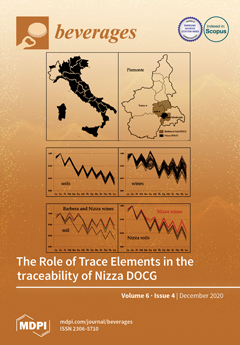Open AccessArticle
Antimicrobial Potential of Beverages Preparation Based on Fermented Milk Permeate and Berries/Vegetables
by
Egle Zokaityte, Vita Lele, Vytaute Starkute, Paulina Zavistanaviciute, Modestas Ruzauskas, Erika Mozuriene, Marina Cepiene, Vidas Ceplinskas, Gintare Kairaityte, Rasa Lingyte, Laurynas Marciulionis, Ema Monstaviciute, Meda Pikunaite, Migle Smigelskyte, Enrika Vyzaite, Laima Zilinskaite, Romas Ruibys and Elena Bartkiene
Cited by 4 | Viewed by 3796
Abstract
Nowadays, taking into consideration the current dynamics of drug resistance development, many researchers are working to develop new antimicrobial compound combinations for the food and beverage industry, which can overcome this problem. The aim of this study was to evaluate the antimicrobial properties
[...] Read more.
Nowadays, taking into consideration the current dynamics of drug resistance development, many researchers are working to develop new antimicrobial compound combinations for the food and beverage industry, which can overcome this problem. The aim of this study was to evaluate the antimicrobial properties of milk permeate fermented with
Lactobacillus plantarum LUHS135,
Lactobacillus plantarum LUHS122, and
Lactobacillus faraginis LUHS206 strains in combination with berry/vegetable (B/V) pomace (gooseberries, chokeberries, cranberries, sea buckthorn, rhubarb) against a variety of pathogenic strains (methicillin-resistant
Staphylococcus aureus,
Citrobacter freundii,
Klebsiella pneumoniae,
Salmonella enterica,
Bacillus cereus,
Pseudomonas aeruginosa,
Acinetobacter baumanni,
Proteus mirabilis,
Enterococcus faecalis,
Enterococcus faecium,
Streptococcus mutans,
Streptococcus epidermis,
Staphylococcus haemolyticus,
Pasteurella multocida, and
Enterobacter cloacae) as a potential antimicrobial combination for beverage preparation. The highest number of the tested pathogenic strains was inhibited by gooseberries, sea buckthorn, and rhubarb combinations with strain LUHS122 fermented beverages (13 pathogens out of 15 tested). Twelve out of 15 tested pathogens were inhibited by gooseberry combinations with LUHS135 and LUHS206 fermented milk permeate. Selected B/V in combination with fermented milk permeate are promising antimicrobial ingredients for beverage preparation, possessing antimicrobial activity almost against all the tested pathogenic strains.
Full article
►▼
Show Figures





